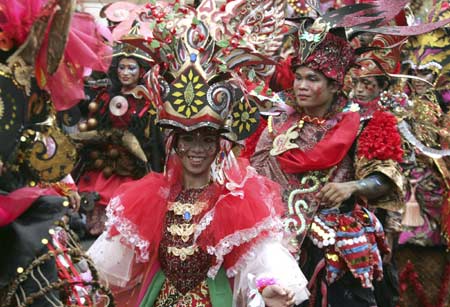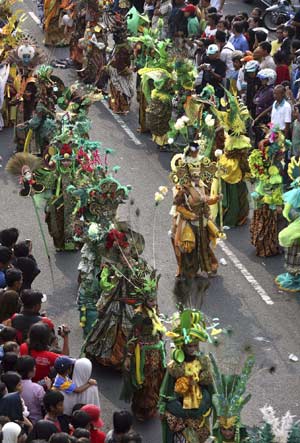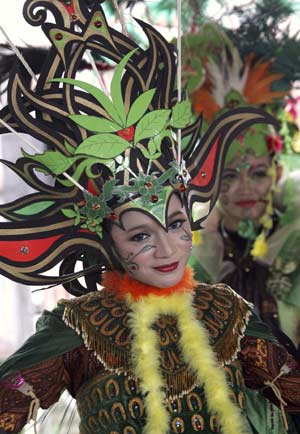













 TOO SEXY FOR BATIK: Models present modern batik clothes at the opening of the West Java Batik Exhibition at the Textile Museum in Central Jakarta on Tuesday. The museum organizes the two-week exhibition to promote West Javan batik.
TOO SEXY FOR BATIK: Models present modern batik clothes at the opening of the West Java Batik Exhibition at the Textile Museum in Central Jakarta on Tuesday. The museum organizes the two-week exhibition to promote West Javan batik.Batik took to the catwalk Tuesday in a flashy display of modern fashion during the opening of the West Java Batik Exhibition at the Textile Museum in Central Jakarta.
"I thought batik only came from Central Java. I never heard of West Java batik before," said a visitor to the exhibition, which is being held until Nov. 23.
West Java Batik, based on a tradition dating back to 1430, is not as well known as batik from Solo, Yogyakarta and Pekalongan.
"Only a few people know that West Java has its own traditional batik, which comprises the history and philosophy of the region in its beautiful motifs," said Dyah Damayanti, the head of the museum.
The exhibition, titled "West Java Tradition", displays about 100 various kinds of batik from several areas in West Java, such as Tasikmalaya, Ciamis, Garut, Cirebon, Bandung and Indramayu.
"In some West Java areas, batik is already extinct, like batik Ciamis," Dyah said.
West Java Batik features motifs derived from the Sunda culture, which was influenced by both Hindu and Islam as well as cultures from China, India and the Netherlands.
Among the most recognizable of the West Java batik motifs are buketan galang gasi, parang kembang, lunglungan, urang ayu and mega mendung.
West Java batik is different from Central Java batik because of its use of vibrant colors like green, red, orange and blue.
Antique batik fabrics are on display at the exhibition, including a rare 300-year-old banner from Cirebon that features Arabic calligraphy.
"We hope that this event will inform visitors that Indonesia has many places with a unique batik style," Dyah said.
The fashion show featured the designs of several prominent batik designers and producers in Indonesia, such as Danar Hadi, Komar, Tiga Putri and Warna Alam Roso.
The exhibition is the result of a scenography workshop held in cooperation with the Dutch government. (naf)
Textile Museum
Jl. KS Tubun No. 4
Tanah Abang, Central Jakarta
Opening hours:
Tuesday - Thursday, Saturday - Sunday
9:00 a.m. to 3:00 p.m.
Friday
9:00 a.m. to 12:30 p.m.
Monday and public holidays: closed
from: http://www.thejakartapost.com
 Models present creations made from traditional batik cloth during Solo Batik Carnival in Solo, Central Java province, in Indonesia, June 28, 2009.
Models present creations made from traditional batik cloth during Solo Batik Carnival in Solo, Central Java province, in Indonesia, June 28, 2009. Models present creations made from traditional batik cloth during Solo Batik Carnival in Solo, Central Java province, in Indonesia, June 28, 2009
Models present creations made from traditional batik cloth during Solo Batik Carnival in Solo, Central Java province, in Indonesia, June 28, 2009







An exhibition in Jakarta featuring the batik collection of the US President Barack Obama’s mother was officially opened in Jakarta on Tuesday.
Speaking at the occasion, Maya Soetoro, Obama’s half-sister, said their mother, Ann Dunham, collected batik as part of her efforts to understand Indonesian culture. Dunham passed away from ovarian cancer in 1995.
Maya said their mother had told them that culture was a good way to build international relationships.
The exhibition features Dunham’s collection of batik from Yogyakarta, Solo and Pekalongan in Central Java; Indramayu and Cirebon in West Java; and Madura, East Java.
The exhibition will also display the collections of first lady Ani Yudhoyono and Go Tik Swan, a renowned batik designer from Central Java.
A fashion show of batik dresses designed by Agus Susastro, an Indonesian designer living in New York, was the highlight of the opening.
Ani, who officially opened “The Batik Essay, a Collection of Love Stories” at Grand Indonesia mall, said batik — recently proclaimed by Unesco as Indonesian cultural heritage — was a medium for understanding the nation.
“Through this expo, one can picture a story of someone who loved batik very much,” Ani said, referring to Dunham.
Ani also recalled that when she was a child, her mother, Sunarti Sri Hadiyah, the wife of the late Sarwo Edhie Wibowo, introduced her to various batik designs and taught her how to choose certain designs for certain occasions.
Ani said she was proud of her mother and her role in preserving the tradition found in batik.
Trade Minister Mari Elka Pangestu, said on Monday that the exhibition was to welcome Obama, who spent part of his childhood in Indonesia.
“This is a symbol of the US partnership with Indonesia as well as Mr. Obama’s appreciation of [our culture],” she said, as quoted by VIVAnews.

Seven young people from Bandung, West Java, grouped together as the Bluemoon Technology-Pixel People Project have introduced a potentially revolutionary innovation to the world of batik design in Indonesia with the launch of their Batik Fraktal V2 software, which enables batik to be designed without human intuition.
The software, development of which began in late 2007 with the support of the Agency for the Assessment and Application of Technology, the Research and Technology Ministry and a grant from Senada-USAID, enables designs to be made by a computer, which processes traditional batik design patterns into millions of new motifs by using fractal mathematics formulas.
The software launching ceremony was held at the Blitz Megaplex in Bandung recently and was attended by Research and Technology Minister Kusmayanto Kadiman, head of the West Java Industry and Trade Office Agustiar and representatives from Senada-USAID.
Nancy Margried, who served as project manager for the Pixel People Project, said the software allows traditional batik makers to design an unlimited number of motifs. She added the basic forms in the software, such as angles, length and repetitive motifs, were taken from traditional batik motifs, such as from Pekalongan, Garut, Yogyakarta and Surakarta.
"We have included a number of basic motifs, such as angles, length and motif duplication in the database so as to facilitate making batik motifs," Margried said.
Minister Kusmayanto said his ministry had provided support to the Batik Fraktal software given its extraordinary innovation, which combines art, computer, mathematics and economics.
"I am impressed because the innovation could expand batik sales extensively. Batik, which was regarded as traditional and out-moded, can now become a trend among the younger generation with its new and up-to-date designs," Kusmayanto said.
Nancy said batik fabrics could be made manually by using the traditional manner and the computer designs could easily be downloaded to the batik printing machines for mass production. Besides government agencies, Nancy said demand for the Batik Fraktal software was also sought after by customers from Australia, the United States and Singapore.
"We sell it in the form of software, design and finished products, but our capital is still limited so we have to bring in new investors."
They have decided to provide the software free to traditional and small-scale batik makers, but have set a high price for large-scale companies and overseas orders so as to protect local batik makers.
In Cirebon, traditional batik makers have aired their concern over the influx of Chinese-made batik products flooding the domestic market, including those producing the local Cirebon batik, better known as Trusmi.
They are afraid the Chinese-made batik could wipe out the local batik industry, which is managed traditionally.
The batik makers have urged the government to act immediately to anticipate the problem and take serious moves to protect the traditional batik industry, which is part of the national cultural wealth.
"The government should act quickly to prevent the invasion of Chinese-made batik," Katura, an elder member of the Trusmi Traditional Batik Artisans Association, said.
from: jakartapos